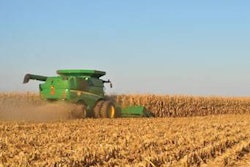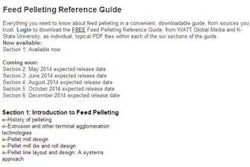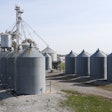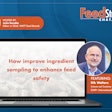
Aquaculture is the world’s fastest growing food sector, increasing by nearly 900 percent over the last two decades – and further expansion is imminent. Researchers at the World Resources Institute (WRI) suggest that the sector will need to grow by 133 percent by 2050 to meet the protein needs of 9 billion people. According to the United Nation’s Food & Agriculture Organization (FAO), fish farms will account for this increased production and nearly half of these farmed species will be dependent on compound aqua feeds. With this trend comes the question: How can the world’s producers improve on existing production and nutrition practices to make fish farming more sustainable into the future?
In the United States, Bell Aquaculture, an Albany, Indiana-based fish producer, wants to be a leader in responsibly feeding and rearing the fish of tomorrow. Its President and CEO Norman McCowan’s passion for aquaculture and innovation led the company toward building a vertically integrated aquaculture farm with an emphasis on research and development. For this reason, Bell Aquaculture is focused on sustainable, fishmeal-free diets for its environmentally friendly “recirculating” fish tanks.
“[McCowan] and the board truly want to change the aquaculture industry, and they want to aid in developing the U.S. aquaculture industry,” says Dr. Steve Craig, Bell’s director of feed development. “A lot of fish farmers are very secretive, but Bell has always been very open and not afraid to share its technologies to help other people in the industry. The end goal is to produce sustainable seafood domestically.”
Greener fish farming
Bell Aquaculture as it exists today is the result of the recent merger of three companies that complete McCowan’s vision for vertical integration: fish farm, Bell Aquaculture; aquaculture technology company, Low Salinity Incorporated; and feed manufacturer, Integral Fish Foods Inc. The company grows trout, salmon and perch; manufactures and sells aqua feed; and produces fertilizer.
Bell Farms, the outward facing brand of Bell Aquaculture’s fish, feed and fertilizer businesses, manufactures aqua feeds for many different species of fish, including salmon, trout, hybrid striped bass, largemouth bass, yellow perch, Florida pompano, cobia and tilapia, as well as a feed designed specifically for aquaponics. In total, Bell currently raises 2.2 million pounds of fish in its state-of-the-art, land-based recirculating aquaculture systems (RAS) facility. According to Craig, less than 10 percent of U.S. aquaculture utilizes this technology.
RAS farms are closed-loop production systems that continuously filter and recycle the tank water, producing little or no pollution. In addition to water losses of less than 1 percent, the system also allows the producer to reclaim the fish manure and waste products and use them as fertilizer.
“Recirculating aquaculture systems use very little water,” Scott Nelson, director of feed mill operations, explains. “The facilities can be placed anywhere and allow companies to set up shop near their customer base — and that offers a big benefit to the industry.”
In addition to its responsible fish farming, Bell locally sources more than half of its feed ingredients, primarily soy, in a bid to lower its freight costs; reduce its environmental footprint; and to aid in keeping its diets cost effective and competitive.
Nutrition generates waste reduction
Many aqua feed formulations are designed for either net pen or flow-through production systems where the waste from the fish and feeds are removed from the system through water flow. Since RAS facilities require the waste to be removed it poses a unique challenge for the operator.
“Optimal water quality helps promote the growth and health of the fish, but it also reduces costs in terms of extracting those materials out of the water,” Craig explains, noting that modified formulations are required to receive the best results from a RAS operation.
In formulating its RAS-compatible feeds, Bell Farms has access to complete testing facilities and the means to conduct long-term feeding trials.
“As we develop new feed formulations, the biggest thing that we’re going to be working on is the effect of the feed on the water quality,” Nelson reports. “The feed has a dramatic effect on how well you can clean the water, how much you can feed and how much the fish will grow.”
This testing capability has allowed the company to experiment with alternative feed ingredients to improve upon its existing formulations while maintaining its competitive feed costs.
Adoption of an alternative protein
One of Bell Aquaculture’s goals has been to develop plant-based fish diets meant to eliminate the need for fish meal.
“As long as you hit the key targeted nutrients that fish meal supplies, it doesn’t matter to the fish what protein source you use,” says Craig, who has worked in fish nutrition for more than 25 years. “They’re utilizing the amino acids and those specific nutrients. We pay very close attention to the balanced amino acid profile and key micro-nutrients that we’ve discovered over the years are important when you eliminate fish meal.”
The quest to derive highly concentrated protein from alternative ingredients for the fish industry led John Hamilton and three of his business partners to form the company, Adaptive Bio Resources LLC, in 2009. Working with the USDA’s Agricultural Research Service Fish Experiment Station in Bozeman, Montana, under the guidance of Dr. Rick Barrows, the team began searching for new ingredients and sustainable fish meal substitutions.
Ultimately, the waste products in the California nut industry proved the most promising, specifically with off-specification pistachio nuts that are unsuitable for human consumption. In raw form, the nuts contain too much oil for aqua feed, but with heat-free processing, the oil extraction produces an optimal meal while keeping the protein intact. The oil co-product can also be used as a cost-effective substitute for fish oil.
Once the nutrition data had been collected, Hamilton began replacing fish meal at a low rate until they discovered that the mixed nut cake could replace 100 percent of the fish meal in the diet with equal or better efficiency. In 2013, Adaptive Bio Resources began producing “Mixed Nut Feed,” the name designated by the Association of American Feed Control Officials (AAFCO).
“I can produce a decent volume of product – and we were confident in the results of the tank studies – but what I needed was someone to take it to the next level and use it in a commercial study,” explains Hamilton, who worked in animal production before he retired.
During this time, Dr. Barrows had been in contact with Craig about the developments in this area of ingredient research. Craig, who was looking for an aqua feed protein solution, was eager to try it out.
Aqua feed R&D
Aside from generating feed sales and formulating feeds to meet the dietary requirements of the fish, Craig works in a secondary role in Bell Aquaculture’s research and development division.
“We continue to innovate our feeds based on our research and use the findings in large scale work that we do on site to integrate into our production feeds, just to continually improve them,” Craig explains.
Bell, who also manufacturers feed for other aquaculture operations, adopted the mixed nut product for itself as well as the other producers it serves. Craig is using the ingredient to formulate some of Bell’s higher-end diets. To date, Bell has had much success with mixed nut feed; 35 percent of the company’s feed production contains it and the oil byproduct.
“Fish farming is like any other form of farming – it’s a tough business and the margins aren’t really very large,” Craig says. “The challenge is to incorporate some of these more sustainable formulations while keeping the cost of the diet within reason – and we’re achieving that.”
Bell uses one-third of its aqua feed production; the other two-thirds are sold nationally to other fish farms.
















